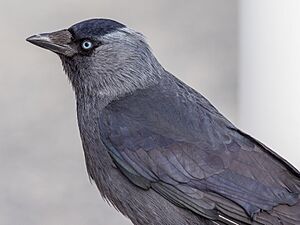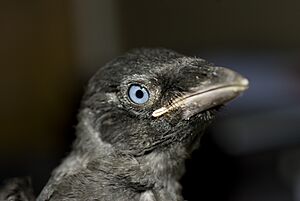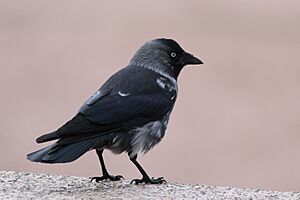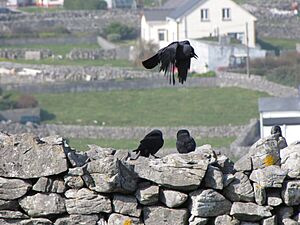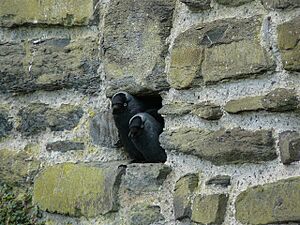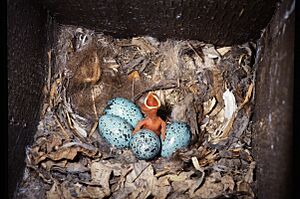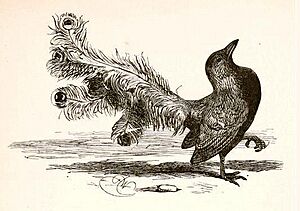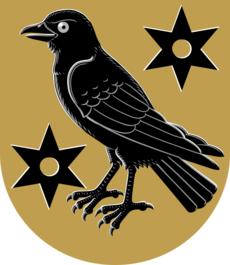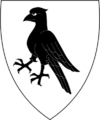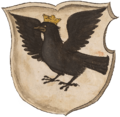Western jackdaw facts for kids
Quick facts for kids Western jackdaw |
|
|---|---|
 |
|
| Coloeus monedula |
|
| Conservation status | |
| Scientific classification | |
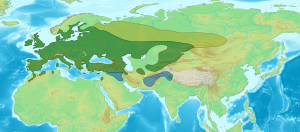 |
|
|
Jackdaw range summer-only range winter visitor only |
|
| Synonyms | |
|
Corvus monedula Linnaeus, 1758 |
The western jackdaw (Coloeus monedula) is a clever bird in the crow family. You might also hear it called the Eurasian jackdaw or just jackdaw. These birds live across Europe, western Asia, and North Africa. Most western jackdaws stay in one place all year. However, those from colder northern and eastern areas fly south for the winter.
Western jackdaws are about 34 to 39 centimeters (13–15 inches) long. They have shiny black feathers with a grey neck and bright pale-grey eyes. They are very social and noisy, living in groups with a complicated social system. You can find them in farmlands, open woods, on coastal cliffs, and even in cities. Like their crow relatives, jackdaws are smart birds. They have even been seen using tools! They eat many different things, from plants and insects to food scraps. Western jackdaws stay with one partner for life. They build simple nests of sticks in holes in trees, cliffs, or buildings. The female lays about five pale blue or blue-green eggs. The young birds leave the nest after four to five weeks.
Contents
About the Western Jackdaw
Naming the Jackdaw
The famous scientist Carl Linnaeus first officially described the western jackdaw in the 1700s. He gave it the scientific name Corvus monedula. The word monedula comes from a Latin word meaning "money." This is because people thought jackdaws liked to pick up coins.
The common name "jackdaw" first appeared in the 1500s. It combines "jack," which means "small" (like in "jack snipe"), and "daw." "Daw" was an older English name for this bird. Some people think the "jack" part comes from the bird's metallic "chyak" call.
Scientists sometimes place jackdaws in their own group, Coloeus. This name comes from an ancient Greek word for jackdaw. But many still keep them in the Corvus group with other crows.
Jackdaw Family Tree
Scientists use DNA to understand how birds are related. Studies show that the western jackdaw and its close cousin, the Daurian jackdaw, are a bit different from other birds in the Corvus family. Because of this, some scientists now use the name Coloeus monedula for the western jackdaw. The Daurian jackdaw lives in eastern Russia and China. Sometimes, these two types of jackdaws can even have babies together where their homes overlap.
Different Kinds of Jackdaws
There are four main types, or subspecies, of the western jackdaw. They mostly look different in the color of their head and neck feathers. Where their homes meet, these different types can mix.
- The Nordic jackdaw (C. m. monedula) lives in eastern Europe, including Scandinavia. It has a pale neck and sides of the neck. It also has a light grey collar that can be different sizes.
- The Western Eurasian jackdaw (C. m. spermologus) is found in western, central, and southern Europe, and North Africa. This type is darker than the others. It does not have a whitish border at the bottom of its grey neck.
- The Eastern Eurasian jackdaw (C. m. soemmerringii) lives in northeastern Europe and parts of Asia. Its neck and sides of the neck are paler. This makes its black head stand out more.
- The Algerian jackdaw (C. m. cirtensis) lives in Morocco and Algeria in Northwest Africa. Its feathers are duller and more evenly dark grey. Its paler neck is not as clear as in other types.
What a Jackdaw Looks Like
The western jackdaw is about 34 to 39 centimeters (13–15 inches) long and weighs around 240 grams (8.5 ounces). Most of its body is shiny black. Its head, forehead, and some wing feathers have a purple or blue shine. Its throat and tail feathers have a green-blue shine. The cheeks, back of the neck, and sides of the neck are light grey. Its belly is slate-grey.
Jackdaws have black legs and a short, strong black beak. Bristles cover about 40% of the top part of the beak. Adult jackdaws have grey or silvery-white eyes. Young jackdaws have light blue eyes that turn brownish before becoming white at about one year old. Male and female jackdaws look similar. However, the male's head and neck feathers can fade more as they get older. Jackdaws replace all their feathers between June and September. The purple shine on their cap is brightest right after this happens.
Young jackdaws have duller feathers that are not as clearly marked. Their head is sooty black, and their neck is dark grey. Their belly is greyish or sooty black.
Jackdaws are skilled flyers. They can turn sharply, tumble, and glide. When they fly, their wing beats are jerky, but not when they are migrating. On the ground, they stand upright and walk quickly with their short legs. They often feed with their heads down.
It is easy to recognize a western jackdaw because of its short beak and grey neck. From far away, it might look like a rook or a pigeon. When flying, jackdaws are smaller than other crows. They have faster, deeper wingbeats and narrower wing tips. They also have shorter, thicker necks and much shorter beaks. They often fly in tighter groups.
Jackdaw Sounds
Western jackdaws are very noisy birds. Their main call, often heard when flying, is a metallic and squeaky "chyak-chyak" or "kak-kak." This call is used to keep in touch or to greet others. Adults make a "kiaw" or "kyow" sound to call their young. Males also use it when giving food to their mates. Females make a longer "kyaay" or "giaaaa" sound when asking males for food.
When perched, jackdaws often chatter together. Before they settle down for the night, large groups make a cackling noise. Jackdaws also have a harsh, long alarm call, "arrrrr" or "kaaaarr." They use this to warn others about predators or to chase them away. Young birds start making a soft "cheep" when they are about a week old. Their voices get louder as they grow. By day 18, their call is a loud screech. After that, their voice gets deeper and softer. Young jackdaws become quiet if they hear an unfamiliar noise. Jackdaws can even be trained to copy human speech.
Where Jackdaws Live
Western jackdaws live from Northwest Africa, across all of Europe (except the far north), and east through central Asia to the eastern Himalayas. They are also found in Turkey, Iran, Iraq, Afghanistan, and parts of India. They used to live in Malta and Tunisia but are no longer found there. Their home range is huge, covering millions of square kilometers. There are many jackdaws in the world, with an estimated 15.6 to 45 million in Europe alone.
Most jackdaw groups stay in one place. But those in the north and east move more. They fly to warmer places for winter between September and November. They return home between February and early May. Their range expands north into Siberia during summer and shrinks in winter.
Western jackdaws like places with woods, fields, farms, coastal cliffs, and towns. They do well when forests are cleared for fields. They prefer areas with a mix of large trees, buildings, and open ground. They leave wide-open fields to rooks and very wooded areas to jays. In winter, some jackdaws gather in city parks. Their numbers in parks have increased, possibly because they move there from colder northern areas.
Jackdaw Behavior
Jackdaws are usually shy of people in forests. But in cities, they are much tamer.
Western jackdaws are very social. They are usually seen in groups of different sizes. Males and females form pairs for life, and these pairs stay together within the larger groups. Flocks get bigger in autumn. Birds gather at dusk to sleep together, with thousands of birds in one spot. In Sweden, 40,000 birds have been seen at one winter roost. Mated pairs often sleep together.
Jackdaws often gather with other birds like hooded crows or rooks. They have been seen looking for food with starlings and gulls. Larger groups of jackdaws are better at escaping predators like falcons. Jackdaws sometimes chase away bigger birds like magpies or ravens. One jackdaw will make an alarm call, and others will gather to attack as a group. Sometimes, a sick or hurt jackdaw is attacked by others until it dies.
The scientist Konrad Lorenz studied jackdaws living around his house. He found that jackdaws have a clear social order, like a pecking order. Higher-ranked birds control lower-ranked ones. Mated pairs share the same rank. Young males figure out their place before they find a mate. Once a female pairs with a male, she gets the same social rank as him. Unmated females are at the bottom of the social ladder. They are the last to get food and shelter. Lorenz noticed that all the jackdaws in a group quickly understood the new social order.
Social Signals
Jackdaws show their social rank through actions like taking another bird's spot, fighting, and threat displays. In the "bill-up posture," a jackdaw points its beak and head up and smooths its feathers. This shows both that it wants to be peaceful and that it is confident. Birds use this when they want to join a group that is eating.
The "bill-down posture" is another common way they show aggression. The bird lowers its beak and raises its neck and head feathers. Sometimes it lifts its wings a little. Jackdaws often face each other in this pose until one backs down or a fight starts. In the "forward-threat posture," a bird holds its body flat and pushes its head forward. If it is very angry, it will ruffle its feathers and spread its tail or wings. This is seen when they are fighting over nests or mates. In the "defensive-threat posture," the bird lowers its head and beak, spreads its tail, and ruffles its feathers.
"Supplanting" is when one bird moves in and takes another bird's spot. The second bird usually leaves without a fight. Jackdaws fight by jumping at each other feet-first. Then they wrestle with their feet tangled and peck each other. Other jackdaws gather and call loudly.
Jackdaws ask their partners to groom them by showing their neck and ruffling their head feathers. Birds mostly groom each other's heads and necks. This is called "allopreening" and is almost always done between mated pairs.
Jackdaw Reproduction and Life Cycle
Western jackdaws are ready to have babies when they are two years old. They stay with the same partner for life. They rarely separate, even if they have trouble raising young. If a partner dies, the widowed bird often has a hard time. They might be kicked out of nests and cannot raise babies alone.
Jackdaws usually nest in groups called colonies. Pairs work together to find a nest spot. They then protect it from other pairs and predators. They nest in holes in trees or cliffs, in old buildings, or in chimneys. They need a safe, sheltered place for their nest.
Jackdaws build their nests by dropping sticks into a crack. They then build on top of this stick platform. This can sometimes block chimneys!
Nests are lined with soft materials like hair, wool, and dry grass. The eggs are lighter in color than other crow eggs. They are smooth, shiny, and pale blue or blue-green with darker speckles. A group of eggs, called a clutch, usually has 4 or 5 eggs. The female sits on the eggs for 17–18 days until they hatch. The chicks are born naked and helpless. They depend completely on their parents for food. They leave the nest after 28–35 days. Their parents continue to feed them for about four more weeks.
If there is not much food, parents might not feed the last-hatched chick as much. This is because it is less likely to survive.
Some birds, like the great spotted cuckoo, lay their eggs in jackdaw nests. Other animals, like ravens, owls, weasels, and rats, sometimes steal eggs or chicks from jackdaw nests.
What Jackdaws Eat
Jackdaws mostly look for food on the ground in open areas. They also look in trees, at landfills, in bins, on streets, and in gardens. They use different ways to find food. They jump, peck, turn over dirt clods, and dig. They might catch flies around cow pats by jumping or dropping down from above. They eat earthworms from freshly plowed soil. Jackdaws will even ride on the backs of sheep to find ticks or collect wool for their nests. They also catch flying ants in the air.
Jackdaws eat small insects and other invertebrates, like beetles, flies, and spiders. They also eat small rodents, bats, and the eggs and chicks of other birds. They will also eat dead animals. For plants, they eat farm grains (like barley and wheat), weed seeds, berries, and fruits. When they are not raising young, their diet is mostly plant material. But when they are breeding, they eat more insects.
Jackdaws are very good at finding food and can change what they eat depending on what is available. They have been seen taking eggs and young birds from the nests of skylarks, shearwaters, and pigeons. Jackdaws will also steal food from other birds.
Jackdaws share food with other jackdaws, even if they are not related. They share more of their favorite foods. Most birds only share food when they are caring for their young or trying to find a mate. Jackdaws share food much more often than other animals, even chimpanzees! Scientists are still trying to understand why they do this. It might be to help each other, to get something back later, or to avoid trouble. Some think it might even be to show off.
Jackdaws and People
Jackdaws have learned to peck open the foil caps on milk bottles left on doorsteps. Bacteria from their beaks can get into the milk. This has been linked to people getting sick. Because of this, health officials suggest throwing away milk from bottles that have been pecked open. They also recommend steps to stop birds from opening bottles.
Jackdaws have been hunted in the past because people thought they were pests. In the 1500s, a law was made in England to control jackdaws, crows, and rooks. This was to protect grain crops. Jackdaws were also known for eating fruit, especially cherries. They were also controlled on hunting estates because they would raid other birds' nests for eggs.
Today, in the United Kingdom, it is legal to use jackdaws as decoys or trap them in cages. This is done to manage their numbers if they are causing problems.
Jackdaws in Stories and Art
An old saying from Ancient Greece and Rome goes, "The swans will sing when the jackdaws are silent." This means that smart people will speak only after foolish people have stopped talking. In ancient Greek stories, a jackdaw could be caught with a dish of oil. The jackdaw, being vain, would fall in while looking at its reflection.
In Roman times, the poet Ovid said jackdaws could predict rain. Pliny the Elder wrote that people in some areas liked jackdaws because they ate grasshopper eggs.
In some cultures, a jackdaw on a roof is said to mean a new baby is coming. But in other stories, a jackdaw on a roof or flying down a chimney is a sign of death. Seeing one can be a bad omen. In Czech stories, if jackdaws are fighting, it means war will follow.
In Welsh folklore, the jackdaw was considered special because it nested in church steeples. People believed the Devil avoided it because of where it lived. In the 1800s, people in England believed seeing a jackdaw on the way to a wedding was good luck for the bride.
The jackdaw is on the old coat of arms of the Ukrainian town of Halych. The town's name might even come from an old word for the bird. In a book called The Book of Laughter and Forgetting, the author notes that Franz Kafka's father had a sign with a jackdaw on it. This is because "kavka" means "jackdaw" in Czech.
In the video game Assassin's Creed IV: Black Flag, the main character's ship is named the Jackdaw.
-
Flag of Halych land at the Battle of Grunwald 1410
-
Coat of arms of Ivano-Frankivsk Oblast



